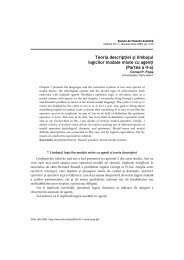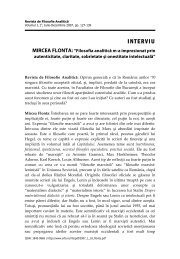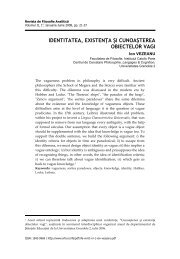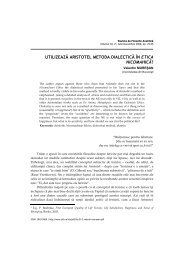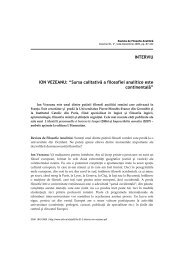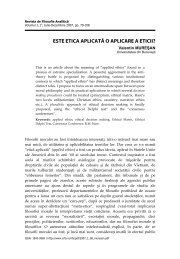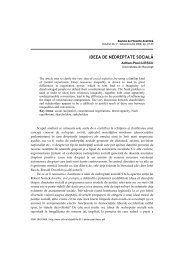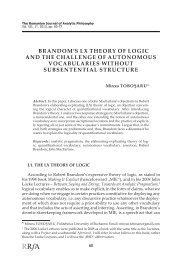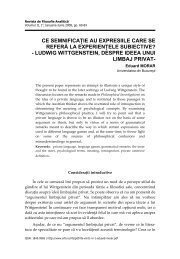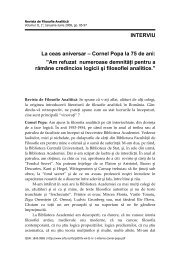AN ANALYSIS OF KRIpKE'S ARguMENT AgAINST THE IDENTITY ...
AN ANALYSIS OF KRIpKE'S ARguMENT AgAINST THE IDENTITY ...
AN ANALYSIS OF KRIpKE'S ARguMENT AgAINST THE IDENTITY ...
You also want an ePaper? Increase the reach of your titles
YUMPU automatically turns print PDFs into web optimized ePapers that Google loves.
Revista Română de Filosofie Analitică<br />
Volumul VI, 2°, Iulie‐Decembrie 2012, pp. 7-16<br />
<strong>AN</strong> <strong>AN</strong>ALYSIS <strong>OF</strong> KRIPKE’S<br />
ARGUMENT AGAINST<br />
<strong>THE</strong> <strong>IDENTITY</strong> <strong>THE</strong>SIS<br />
Jason TYNDAL 1 *<br />
Abstract : In this paper, I provide a critical analysis of Kripke’s claim that „pain =<br />
C‐fiber firings“ is not necessary. Kripke’s claim depends on accepting the plausibility<br />
of a possible world in which either pain or C‐fiber firings can occur without<br />
the other. Against Kripke, I argue that we do not have a good reason to accept<br />
the plausibility of such a world. On my view, the tendency to accept the plausibility<br />
of such a world is likely motivated by certain intuitions and experiences<br />
which can misleadingly shape our discourse about possible worlds. From this, I<br />
conclude that it is not obvious that „pain = C‐fiber firings“ cannot be necessary.<br />
Keywords : identity thesis, „pain = C‐fiber firings“, possible worlds, rigid designation,<br />
necessity.<br />
I. INTRODUCTION<br />
In Naming and Necessity, Kripke challenges the thesis that pain just is the<br />
stimulation of C‐fibers. He calls this the „identity thesis.“ His argument is<br />
that if pain is identical to some set of C‐fiber firings, then that identity relation<br />
must be necessary. But since it cannot be necessary, pain cannot be identical<br />
to C‐fiber firings.<br />
In this paper, I challenge Kripke’s basis for the claim that „pain = C‐fiber<br />
firings“ is not necessary. I will proceed as follows. In §2, I lay out the relevant<br />
Kripkean terminology. This entails a discussion of possible worlds, rigid<br />
designation, and necessity. In §3, I present Kripke’s full argument against<br />
the identity thesis. Finally, in §4, I argue that accepting the claim that „pain =<br />
C‐fiber firings“ is not necessary depends on first accepting the plausibility<br />
of a possible world in which either pain or C‐fiber firings can occur without<br />
* Jason TYNDAL, Professor at Tulane University, Department of Philosophy. For correspondence<br />
use the address : jtyndal@tulane.edu.<br />
7
Jason TYNDAL<br />
the other. As I see it, however, this is not a plausibility that should be accepted.<br />
While I recognize that there is a strong tendency to accept it, I suspect<br />
that this tendency is motivated by some common intuitions and experiences<br />
which may misleadingly shape our views about what is possible.<br />
II. SOME KRIPKE<strong>AN</strong> TERMINOLOGY<br />
Before taking up Kripke’s treatment of the identity thesis, I must briefly<br />
review his conceptions of possible worlds, rigid designation, and necessity.<br />
What Kripke means by a possible world is world which represents how<br />
things could have been. For example, while it is the case that Barack Obama<br />
is the 44 th President of the United States, it might have been the case that he<br />
was not the 44 th President. Because our concerns about what might have been<br />
are often narrow in scope, we can think of possible worlds as possible counterfactual<br />
situations. This notion of possible worlds is foundational to understanding<br />
Kripke’s notions of rigid designation and necessity.<br />
Kripke says that a term (a word or expression) is a rigid designator „if<br />
in every possible world it designates the same object… wherever the object<br />
exists.“ 1 While this condition is accurate, it does not, by itself, fully capture<br />
what it is to be a rigid designator. For I do not think that Kripke would want<br />
to call a term a rigid designator if it designates the target object 2 in all possible<br />
worlds in which it exists, but designates something else in a world in which<br />
the target object does not exist. To remedy this, we might say that a term is<br />
a rigid designator if it designates the same object in all possible worlds in<br />
which it designates anything all. But this is also incomplete. A term may designate<br />
the same object in every world in which it designates something at all,<br />
but still fail to designate the target object in a world in which it does exist. 3<br />
Again, I think this does not fully capture what Kripke meant by rigid designator.<br />
Given these concerns, it may be better to say that a term is a rigid designator<br />
if and only if it designates the same object in every possible world in<br />
which the object exists and designates nothing at all in every possible world<br />
in which the object does not exist. 4<br />
1<br />
Kripke, Saul, Naming and Necessity ; Cambridge, MA : Harvard University Press, 1980, pp.<br />
48‐49.<br />
2<br />
By „target object,“ I mean the object that a speaker intends to pick out by their use of a term.<br />
I am setting aside cases in which a speaker’s intentions may not be clear even to the speaker.<br />
3<br />
It is hard to say what sort of term may be a good example here. One possibility is raised by<br />
Soames. The designator „President Obama,“ in which the referent is the man Obama, picks out<br />
Obama in every possible world in which he is a President, but fails to pick out Obama in any<br />
world in which he exists, but is not a President. Soames refers to such designators as partially<br />
descriptive names. As he says, „though not, strictly speaking, rigid designators… they always<br />
designate the same object when they designate anything at all.“ Soames, Scott, Beyond Rigidity ;<br />
Oxford : Oxford University Press, 2002, p. vi.<br />
4<br />
I am setting aside certain difficult cases, such as that of fictional names, which may further<br />
complicate the matter.<br />
8
Revista Română de Filosofie Analitică, VI, 2°, 2012<br />
Kripke argues that proper names qualify as rigid designators. Consider<br />
the name Barack Obama. In this world, I may fix the referent of Barack Obama<br />
by telling you that I am talking about that guy who is the current President<br />
of the U.S. In this world, then, the referent is the man that is named Barack<br />
Obama and is the current President of the U.S. Once the referent is fixed, we<br />
can then begin to talk about that man with respect to possible worlds. In some<br />
possible world – call it PW 1<br />
– it is plausible that Barack Obama never went<br />
into politics. It is equally plausible that, in PW 2<br />
, the man never went into politics<br />
and was not even named Barack Obama. Despite this, identification of<br />
the man across this world and the two possible worlds is feasible. This can<br />
be confusing, for it is difficult to see how we could identify Barack Obama<br />
in a world in which he never went into politics and was never even named<br />
Barack Obama. The key understanding this lies in the following passage :<br />
[W]e do not begin with worlds [both actual and possible]… and then<br />
ask about the criteria of transworld identification ; on the contrary,<br />
we begin with the objects, which we have, and can identify, in the<br />
actual world. We can then ask whether certain things might have<br />
been true of the objects. 1<br />
So, it is because I fixed the referent of Barack Obama in this world that<br />
transworld identification becomes possible. In other words, once the referent<br />
is fixed, we are to focus on the object – in this case, the man – that constitutes<br />
the referent. Only then does it become clear how the name Barack<br />
Obama can pick out the same man in this world as well as PW 1<br />
and PW 2<br />
.<br />
Given this understanding of transworld identification, it does seem that the<br />
name Barack Obama will designate the same man in all possible worlds in<br />
which he exists. If it turns out that Barack Obama did not exist in some possible<br />
world, then it simply means that the name does not designate anything<br />
in that world. Because Kripke thinks the same will hold true of any other<br />
proper name I might fix in this world, he maintains that proper names are<br />
rigid designators.<br />
The only task left in this section is to introduce Kripke’s conception of necessity<br />
into the picture that has been introduced thus far. It is important to<br />
first note that rigid designation should not be confused with necessity. While<br />
it is true that the name Barack Obama must, as a rigid designator, pick out<br />
the same man in all possible worlds in which he exists, it is not necessary<br />
that Barack Obama exists. For Kripke, discourse about possible worlds is discourse<br />
about what is logically possible. Meanwhile, necessity is a metaphysical<br />
concept. 2 As he puts it, something is necessary if it is not possible that „the<br />
1<br />
Kripke [1980] p. 53.<br />
2<br />
Kripke [1980] pp. 35‐36.<br />
9
Jason TYNDAL<br />
world should have been different from the way it is…“ 1 We can recast this as<br />
follows : for something to be necessary, it must be true of all possible worlds.<br />
One way to flesh out Kripke’s conception of necessity is through his discussion<br />
of the statement „Hesperus is Phosphorus.“ The name Hesperus<br />
refers to a celestial body that is visible in the evening sky while the name<br />
Phosphorus refers to a celestial body that is visible in the morning sky. 2 As<br />
proper names, Kripke considers both Hesperus and Phosphorus to be rigid<br />
designators. But we now know that Hesperus and Phosphorus designate<br />
the same object, Venus. This fact was an empirical discovery and, as such, is<br />
known only a posteriori. Still, it is an open question as to whether the statement<br />
„Hesperus is Phosphorus“ is necessary or contingent. This turns on<br />
the following question : is there a possible world in which the object that is<br />
fixed by Hesperus in this world is not identical to the object that is fixed by<br />
Phosphorus in this world If yes, then the identity statement is contingent. If<br />
no, then the identity statement is necessary. Kripke’s conclusion is that the<br />
answer is no : „using the names as we do right now, [we] can say in advance,<br />
that if Hesperus and Phosphorus are one and the same, then in no other possible<br />
world can they be different.“ 3 Because Hesperus and Phosphorus are<br />
rigid designators, they designate the same object in every world in which<br />
the object exists (and designate nothing at all in worlds in which the object<br />
does not exist). But if Hesperus and Phosphorus are designating the exact<br />
same object, then Hesperus must be identical to Phosphorus just as Barack<br />
Obama is identical to Barack Obama. The only difference is that we know a<br />
priori that Barack Obama is Barack Obama, but this is not possible in the case<br />
of Hesperus is Phosphorus. The statement „Hesperus is Phosphorus,“ then,<br />
is both a posteriori and necessary. 4 The general point that can be drawn from<br />
this example is that if two rigid designators, say R 1<br />
and R 2<br />
, pick out the same<br />
object in all possible worlds, then it is necessary that R 1<br />
=R 2<br />
. That it is necessary<br />
follows from the fact that if R 1<br />
and R 2<br />
designate the same object, then it<br />
is necessary that that object is identical with itself.<br />
III. KRIPKE’S ARGUMENT AGAINST <strong>THE</strong> <strong>IDENTITY</strong> <strong>THE</strong>SIS<br />
Generally speaking, the identity‐thesis holds that mental states are identical<br />
to brain states. However, Kripke is concerned with the particular claim that<br />
1<br />
Ibidem, p. 36.<br />
2<br />
To reiterate, according to Kripke, I can use non‐rigid designators (my descriptions of Hesperus<br />
and Phosphorus) to fix the referents in this world. See ibidem, pp. 143‐144.<br />
3<br />
Ibidem, p. 104.<br />
4<br />
It is not necessary that the object designated by Hesperus and Phosphorus exist in all possible<br />
worlds. It is only necessary that if the object exists, then Hesperus is identical to Phosphorus, as<br />
the names are used in this world.<br />
10
Revista Română de Filosofie Analitică, VI, 2°, 2012<br />
pain is nothing over and above the „stimulation of C‐fibers.“ 1 Furthermore,<br />
his focus is directed primarily at type‐type materialism. 2 According to this<br />
theory, a mental state of a specific type is identical to a brain state of a specific<br />
type. There are of course other materialist theories that attempt to defend<br />
the identity thesis, but since Kripke is mostly concerned with type‐type materialism,<br />
I will restrict my discussion to this theory.<br />
Let us call the mental state that is pain MS 4<br />
and the brain state BS 4<br />
. Let<br />
us also say that BS 4<br />
represents the firing of a particular set of C‐fibers. The<br />
claim of the type‐type materialist, then, is that MS 4<br />
=BS 4<br />
(i.e., pain is identical<br />
to the C‐fiber firings that we refer to as BS 4<br />
). What Kripke points out is that<br />
type‐type materialists intend for their identity statements (such as MS 4<br />
=BS 4<br />
)<br />
to be analogous to other „scientific type‐type identifications.“ 3 One example<br />
of such an identification is „heat = molecular motion.“ Type‐type materialists<br />
rely on this analogy because the statement „heat = molecular motion“<br />
is thought to be an example of contingent identity. But as it turns out, it<br />
is not contingent at all – it is necessary in just the same way that „Hesperus<br />
is Phosphorus“ is necessary. After all, since heat and molecular motion both<br />
designate the same thing in this world (molecular motion), then wherever<br />
that thing exists, it will be necessary that heat = molecular motion. It will be<br />
just as necessary as the statement „molecular motion = molecular motion.“<br />
Consequently, if the type‐type materialist wishes to hold on to the analogy,<br />
then he or she must commit to the following premise : if BS 4<br />
=MS 4<br />
is true,<br />
then it is necessarily true. As Kripke puts it, „the identity theorist is committed<br />
to the view that there could not be a C‐fiber stimulation [an instance of<br />
BS 4<br />
] which was not a pain [an instances of MS 4<br />
] nor a pain which was not a<br />
C‐fiber stimulation.“ 4<br />
Kripke goes on to argue, however, that BS 4<br />
=MS 4<br />
cannot be necessarily<br />
true. He starts with a threefold distinction regarding the case of „heat = molecular<br />
motion.“ We should distinguish between (a) the motion of molecules ;<br />
(b) heat ; and (c) the sensation of heat. As I noted above, the identity between<br />
the motion of molecules and heat is necessary. But what should we say about<br />
the statement „heat = the sensation of heat“ 5 Kripke argues that there may<br />
be a possible world that is inhabited by creatures that do not experience the<br />
sensation of heat (as we know it) when in the presence of heat (the motion of<br />
molecules). Furthermore, it might be the case that such creatures experience<br />
the sensation of heat (as we know it) when in the presence of something besides<br />
heat. Therefore, the statement „heat = the sensation of heat“ must be<br />
contingently true if true at all.<br />
1<br />
Ibidem, p. 98.<br />
2<br />
Ibidem, p. 144.<br />
3<br />
Ibidem, p. 148.<br />
4<br />
Ibidem, p. 149.<br />
5<br />
Since (a)=(b), I could also ask about the status of (a)=(c).<br />
11
Jason TYNDAL<br />
A similar threefold distinction can be made regarding the case of BS 4<br />
=MS 4<br />
.<br />
We should distinguish between (x) [a particular set of] C‐fiber firings ; (y) BS 4<br />
;<br />
and (z) MS 4<br />
(pain). I have said that BS 4<br />
is nothing more than a set of C‐fiber<br />
firings. It does not matter what particular set it is at this time. Now, in agreement<br />
with Kripke, I take the terms „C‐fiber firings“ and „BS 4<br />
“ to be rigid designators<br />
just as the terms „motion of molecules“ and „heat“ are rigid designators.<br />
Further, because „C‐fiber firings“ and „BS 4<br />
“ designate the same thing (a<br />
particular set of C‐fiber firings), the statement „C‐fiber firings = BS 4,<br />
“ if true,<br />
is necessarily true. But what should we say about the statement „BS 4<br />
=MS 4<br />
“ <br />
According to Kripke, the case turns out to be the same as that between heat<br />
and the sensation of heat. There may be a possible world that is inhabited<br />
by creatures that do not experience pain (MS 4<br />
) even when in brain state BS 4<br />
.<br />
Further, it may be the case that such creatures experience pain when in some<br />
other brain state. Therefore, the statement „BS 4<br />
=MS 4<br />
“ must be contingent.<br />
As Kripke construes it, the type‐type materialist has failed to meet his or<br />
her commitment. To repeat, the commitment is this : there cannot be an instance<br />
of BS 4<br />
in which there is not also an instance of MS 4<br />
; nor can there be<br />
an instance of MS 4<br />
in which there is not also an instance of BS 4<br />
. To complete<br />
Kripke’s argument, we may say that because BS 4<br />
=MS 4<br />
cannot be necessarily<br />
true, then it is not true at all that BS 4<br />
is identical to MS 4<br />
. I will turn now to an<br />
evaluation of Kripke’s argument.<br />
IV. REPLY<br />
As explicated in the previous section, Kripke’s argument against type‐type<br />
materialism takes the following form :<br />
1. BS 4<br />
and MS 4<br />
are rigid designators.<br />
2. If BS 4<br />
=MS 4<br />
is true, then it is necessarily true.<br />
3. It is not the case that BS 4<br />
=MS 4<br />
is necessarily true.<br />
4. Therefore, it is not the case that BS 4<br />
=MS 4<br />
.<br />
While some have rejected the truth of (1), I will grant it here. 1 What motivates<br />
(2) is the notion that identity is a relation that must hold necessarily. As<br />
Kripke puts it, „the correspondence between a brain state and a mental state<br />
seems to have a certain obvious element of contingency. [But] we have seen<br />
that identity is not a relation which can hold contingently between objects.“ 2<br />
Therefore, to challenge the second premise, one would need to argue that<br />
identity does not have to be a relation that holds necessarily. Of course, this is<br />
what type‐type materialists thought they were arguing when they compared<br />
1<br />
Feldman, for example, argues that the mental state, „my being in pain at t“, is non‐rigid. See<br />
Feldman, Fred, Kripke’s Argument Against Materialism ; in „Philosophical Studies“, 24, 1973, pp.<br />
416‐419.<br />
2<br />
Kripke [1980] p. 154.<br />
12
Revista Română de Filosofie Analitică, VI, 2°, 2012<br />
their case to that of heat and molecular motion. But as Kripke pointed out,<br />
that so‐called case of contingent identity was an illusion. Another option is<br />
to dispute (3) by arguing that it really is the case that BS 4<br />
=MS 4<br />
is necessarily<br />
true. In responding to Kripke’s argument against type‐type materialism,<br />
I take up a position that is similar to this second option.<br />
I argue that it is not obvious that the statement BS 4<br />
=MS 4<br />
cannot be necessary.<br />
1 I hope to inject some doubt into the matter by challenging the plausibility<br />
of a possible world in which BS 4<br />
exists without MS 4<br />
or vice versa. Since<br />
I am challenging (3) in the above argument, I will briefly review Kripke’s argument<br />
for that premise. Assuming again that BS 4<br />
and MS 4<br />
are rigid designators,<br />
his argument for (3) runs as follows :<br />
i. If BS 4<br />
=MS 4<br />
is necessarily true (if true at all), then BS 4<br />
and<br />
MS 4<br />
must occur together in all possible worlds.<br />
ii. There is at least one possible world in which either BS 4<br />
or<br />
MS 4<br />
can occur without the other.<br />
iii. Therefore, BS 4<br />
=MS 4<br />
cannot be necessarily true.<br />
I take issue with (ii). Kripke asks us to imagine a possible world that is<br />
inhabited by creatures that do not experience pain (MS 4<br />
) even when in brain<br />
state BS 4<br />
(and/or vice versa). Call this world Kripkuto. At first glance, this appears<br />
easy to accept, but I am not convinced that it should be accepted. It<br />
seems to me that at least three issues may be clouding our judgment regarding<br />
the plausibility of Kripkuto. While some of these issues may obscure our<br />
judgment more or less than others, any one of them can significantly influence<br />
our views regarding the plausibility of Kripkuto. Once these issues are<br />
brought out into the open, I believe that (ii) becomes questionable.<br />
The first issue is that of actual‐world cases. Such cases, I think, can incline<br />
us to accept the plausibility of Kripkuto. Consider first cases of persons who<br />
suffer from congenital insensitivity to pain (CIP). Such persons can sustain<br />
a broken bone, for example, without experiencing any pain at all. Also consider<br />
those who appear to derive pleasure from self‐mutilation. Both sorts of<br />
cases reflect actual‐world scenarios and, as it turns out, they sound a lot like<br />
something we might expect on Kripkuto. So the inclination may be to quickly<br />
grant (ii) to Kripke (assuming one has such cases in mind). The problem<br />
is that while such cases certainly entail abnormal circumstances, they do not<br />
demonstrate that particular brain states are not identical to particular mental<br />
states (despite the idea that they might, at first glance, imply it). To see<br />
this, we must distinguish between „pain“‐inducing acts, the C‐fiber firings<br />
that are BS 4<br />
, and the mental state of pain that is MS 4<br />
. In CIP cases, genetic<br />
1<br />
The wording here is confusing. I could say that it is not obvious that BS 4<br />
=MS 4<br />
must be contingently<br />
true if true at all. But this wording is problematic given that identity relations, for<br />
Kripke, cannot be contingently true at all. Thus, such wording could make it look as though I<br />
mean to reject premise (2), which I do not.<br />
13
Jason TYNDAL<br />
mutations 1 prevent a „pain“‐inducing act, such as the breaking of a bone,<br />
from bringing about the C‐fiber firings that are BS 4<br />
. As such, neither BS 4<br />
nor<br />
MS 4<br />
are present. Thus, cases of CIP are not applicable to the identity thesis<br />
and, as such, should not be seen as implying the plausibility of Kripkuto.<br />
I do not want to say much about masochism cases, given that masochism<br />
is generally thought to be a psychological rather than genetic condition. All<br />
I want to point out is that masochism cases, like CIP cases, may misleadingly<br />
lend themselves to our considerations about what is possible when talking<br />
about concepts like pain. For example, given our awareness of CIP cases,<br />
it is quite easy to imagine a „genetically‐mutated masochist“ who experiences<br />
some act that is typically thought to be pain‐inducing, but who experiences<br />
some form of pleasure instead of pain. This scenario is plausible because<br />
it could be the case that a „pain“‐inducing act brought about – due to<br />
one or more genetic mutations – some particular brain state that is thought<br />
to be identical with some particular mental state that is pleasure. But, once<br />
again, this does not imply the plausibility of Kripkuto since the „pain“‐inducing<br />
act failed to bring about either BS 4<br />
or MS 4<br />
.<br />
I want to make just one last point regarding the present issue. It seems<br />
to me that possible world discourse often involves talk of creatures that are<br />
said to enjoy a physiological construction that is different from our own.<br />
Consequently, these creatures may respond to environmental conditions<br />
in unique ways. What I want to point out is that physiological differences<br />
should not be a consideration in the case of Kripkuto. After all, if BS 4<br />
does in<br />
fact exist in another world, then it means that a portion of our neurological<br />
construction exists in another world. This has to be so on the grounds that<br />
the thing which BS 4<br />
designates was picked out in this world.<br />
The second issue concerns the human tendency to see the world as a bunch<br />
of cause‐effect relationships. There is good reason for this. Cause‐effect relationships<br />
dominate our picture of the world and, as such, seeing the world<br />
as a cluster of cause‐effect relationships helps us to function in the world.<br />
The worry here is that when Kripke says that a creature on Kripkuto can be<br />
in BS 4<br />
without the experience of pain, the image we are naturally inclined<br />
to create is that of BS 4<br />
failing to cause the experience of pain. But this image<br />
carries with it the assumption that the perceived cause‐effect relationship in<br />
this world is in fact a cause‐effect relationship. Yet, two things involved in a<br />
cause‐effect relationship cannot be identical. Thus, to adopt such an image of<br />
BS 4<br />
and MS 4<br />
, without having a good reason to do so, is to prematurely concede<br />
the very point that is in question.<br />
The third issue concerns the notion of what I refer to here as „epistemic<br />
duality.“ The phenomenological aspect attached to MS 4<br />
brings a certain<br />
complexity to the case of BS 4<br />
=MS 4<br />
that is not present in the case of heat =<br />
1<br />
Nagasako, E.M., Oaklander, A. L., Dworkin, R. H., Congenital Insensitivity to Pain : An Update ;<br />
in „Pain“, Vol. 101, No. 3, 2003, pp. 213‐219.<br />
14
Revista Română de Filosofie Analitică, VI, 2°, 2012<br />
molecular motion. I can learn about BS 4<br />
by studying a particular set of C‐fiber<br />
firings just as I can learn about molecular motion by studying molecular motion.<br />
However, while I can learn about heat while also studying molecular<br />
motion, I can only learn about MS 4<br />
by reflecting on the pain. Now, if it is true<br />
that BS 4<br />
=MS 4<br />
, then it is true that I have two ways to come to know the same<br />
object. But if epistemic duality does not guarantee metaphysical distinctness,<br />
then we should not let the mere notion of epistemic duality persuade us to<br />
accept the plausibility of Kripkuto.<br />
It is important to remember that when we fix the referent of MS 4<br />
in this<br />
world, we cannot allow the intuition that we are fixing something mental to<br />
infect how we view the relationships of that thing in other possible worlds.<br />
After all, we do not yet know whether we are fixing something that is actually<br />
mental, even if our knowledge of that thing is primarily gained from<br />
the phenomenological point of view. In other words, the appearance of distinctness<br />
in this world should not influence our ideas about what is possible<br />
in another world.<br />
In conclusion, I want to re‐emphasize the idea that it may well be the<br />
case that BS 4<br />
and MS 4<br />
are distinct. Hopefully, the issues I have discussed reflect<br />
this as they do not entail assumptions about the truth of BS 4<br />
=MS 4<br />
. Once<br />
more, I have only tried to point out that it is not obvious that BS 4<br />
=MS 4<br />
cannot<br />
be necessary. It seems to me that the willingness to accept the plausibility<br />
of Kripkuto is motivated by a set of issues that, if not sorted out, may invite<br />
us to take as possible a world which is not possible. Part of the problem<br />
is that discourse about what is possible may be tainted by either confusions<br />
or by deeply‐ingrained intuitions and experiences.<br />
BIBLIOGRAPHY :<br />
KRIPKE, Saul – Naming and Necessity ; Cambridge, MA : Harvard University<br />
Press, 1980.<br />
FELDM<strong>AN</strong>, Fred – Kripke’s Argument Against Materialism ; in „Philosophical<br />
Studies“, 24, 1973, pp. 416‐419.<br />
NAGASAKO, E.M., OAKL<strong>AN</strong>DER, A.L., DWORKIN, R.H. – Congenital<br />
Insensitivity to Pain : An Update ; in „Pain“, Vol. 101, No. 3, 2003, pp. 213‐219.



